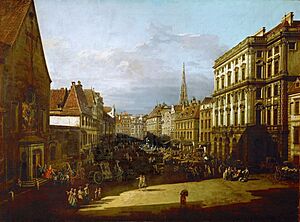Piano Concerto No. 20 (Mozart) facts for kids
The Piano Concerto No. 20 in D minor, K. 466 is a famous piece of music. It features a solo piano playing with an orchestra. Wolfgang Amadeus Mozart wrote this concerto in early 1785. He first played it himself in Vienna, Austria, on February 11, 1785. This concerto is known for being very dramatic and powerful. It has always been a favorite among musicians and people who love classical music.
About the Concerto
Mozart finished writing the Piano Concerto in D minor very quickly. He worked on it from late January to February 10, 1785. The very next day, his father, Leopold Mozart, arrived in Vienna from Salzburg. That evening, Mozart performed the new concerto at a place called the Mehlgrube Casino.
Leopold wrote to his daughter, Nannerl, about the exciting day. He said that the person copying the music was still working on it. Poor Mozart barely had time to practice the last part of the concerto. He had to watch the copyist to make sure everything was right!
Leopold also mentioned that many important people were at the concert. They paid a lot of money to hear Mozart play. He described the concert as "magnificent" and said the orchestra played wonderfully. A singer also performed two songs. Then, they heard the "new and very fine concerto." Mozart played this concerto again a few days later, on February 15, 1785, at the Burgtheater.
The Piano Concerto in D minor is quite serious and emotional. It has moments of strong feelings and dramatic outbursts. This piece was very popular with musicians in the 1800s. Even though it ends on a "happy" note in D major, it's mostly a very intense piece. This concerto is special because it's one of only two concertos Mozart wrote in a minor key. The other one is the Piano Concerto in C minor.
Parts of the Concerto
The Piano Concerto in D minor is written for a solo piano and an orchestra. The orchestra includes a flute, two oboes, two bassoons, two horns, two trumpets, timpani (drums), and strings. This was the first time Mozart used trumpets and drums in one of his piano concertos.
A concerto usually has three main parts, called movements.
- I. First Movement: Allegro
This first part is in D minor and is very fast (Allegro). It uses a musical structure called sonata form. One expert, Ethan Mordden, described it as a fierce struggle. He said the struggle doesn't fully get resolved within this movement. This part of the concerto was quite advanced for its time. It showed how future concertos would feature a powerful solo player against the orchestra.
- II. Second Movement: Romanza
The second movement is a beautiful, lyrical piece. It is in B-flat major and is played at a moderate speed (Andante). This part has a calm, song-like main section. However, it also has a stormy middle section that is more dramatic. It follows a pattern called rondo form (A-B-A-C-A). Just before the end, the music briefly changes to the key of G minor.
- III. Third Movement: Allegro assai
The last movement returns to the key of D minor. It is very fast (Allegro assai). This is one of Mozart's rare rondo movements written in a minor key. It's a longer version of rondo form (A-B-A-C-D-A, with an extra ending part called a coda). The C section develops the musical ideas further. While it goes to G minor for a bit, the movement ends strongly in D major.
Cadenzas
A cadenza is a special part in a concerto where the solo musician gets to show off their skills. It's usually played without the orchestra. Mozart did not write cadenzas for this particular concerto.
However, his son, Franz Xavier Wolfgang Mozart, was also a pianist and composer. He often played this concerto and wrote his own cadenzas for it.
Beethoven, another very famous composer, also loved this D minor concerto. Even though he usually played his own music, he performed Mozart's Piano Concerto in D minor several times. Beethoven also wrote his own cadenzas for the first and third movements. His cadenza for the first movement is especially powerful. It pulls the listener into a world of intense and dramatic music.
Recordings
You can find many recordings of this concerto. Here are a few examples:
- Mozart: Great Piano Concertos. Ashkenazy (conductor & piano), Philharmonia/1997/London 452958.
- Mozart: Piano Concertos 20, 23, 24, 26 & 27. Britten (conductor), Curzon, English Chamber Orchestra/2001/Decca 468491.
- Mozart: Piano Concertos 20 & 23. Marriner (conductor), Moravec, Academy of St Martin in the Fields/Haenssler 98142.
See also
 In Spanish: Concierto para piano n.º 20 (Mozart) para niños
In Spanish: Concierto para piano n.º 20 (Mozart) para niños




